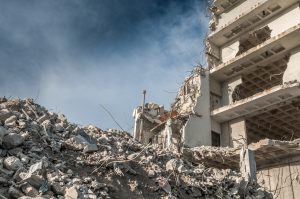Exactly 32 years after its largest earthquake, Mexico City sustained extensive damage from a combination of trepidatory and oscillatory quakes. On Sept. 19, 2017, the combined 7.1 and 8.2 Richter scale measurements made the 2017 quake the second largest in Mexican history.
Despite new, seismic regulations, 3,000 buildings collapsed during the September tragedy. Building experts are fast discovering, however, that seismic retrofitting and stricter regulations present only part of the solution. In 2014, a 6.0 earthquake brought down a seismically-retrofitted 104-year-old building in Napa, California. It is worth noting that many American cities require only the most basic of retrofitting options on buildings. More extensive retrofitting solutions offer better protections, but the higher cost deters contractors.
This is where earthquake engineering services come in. Earthquake engineers are experts in seismic evaluation. Their performance-based philosophy takes into consideration seismic demand and the degree of damage a building can realistically sustain during an earthquake. Additionally, their focus on value engineering delivers cost savings without sacrificing the value of the finished product.
Structural Engineers Help You Maintain Compliance
Many states choose to incorporate the International Code Council's (ICC) seismic codes into their own regulatory framework. These codes include the International Building Code (IBC), International Residential Code (IRC), and International Existing Building Code (IEBC).
The IEBC is in use at some level in all 50 states, especially the ASCE/SEI 7 (minimum design loads for buildings).
An experienced structural engineer can highlight which of the seismic codes are most relevant to your project. These may include the NEHRP's Recommended Seismic Provisions for New Buildings and Other Structures (FEMA P-749), the ACI-318 (Building Code Requirements for Reinforced Concrete), and the ASCE 7-10 (minimum design loads for buildings and other structures).
In 2016, Executive Order 13717 mandated that all federally-funded structures comply with ASCE/SEI 7-10. Notably, earthquake engineers are knowledgeable in how the NEHRP's Recommended Seismic Provisions compare to that of the ASCE/SEI 7. If you operate in any of these five states -- Alaska, Hawaii, California, Washington, or Oregon-- you'll appreciate an earthquake engineer's familiarity with the risk categories ASCE 7-16 (Tsunami Loads and Effects) applies to.
For a structural engineering firm, choose one that employs a performance-based philosophy when assessing structural integrity. Such a firm will clearly define financial costs, downtime expenses, and casualty risks.
Structural Engineers Devise The Best Design Or Retrofitting Approaches
Through earthquake engineering services, you'll discover revolutionary ways to strengthen the design integrity of your buildings. Structural engineers make use of seismic base isolators, vertical and lateral force resisting systems, and tuned mass dampers.
Seismic base isolators and mass dampers are miracles of earthquake engineering. Isolating a building from its foundation lessens the impact of lateral and shear forces during an earthquake. A base isolation system usually consists of a system of bearings and dampers that are placed between the building and its foundation. The isolators and dampers absorb some of the force of the earthquake. They also lengthen a building's period of vibration, lessening damage to its integrity.
Buildings without base isolators sustain greater damage, because they experience greater acceleration and less displacement response to earthquake forces. Base isolator technology is increasing in popularity on the global stage.
For example, the 430,000 square meter Integrated Health Campus in Adana, Turkey, is supported by an astounding 1, 512 base isolators. Meanwhile, Apple's 445,005 square meter corporate headquarters in Cupertino, California, is supported by 700 base isolators. Together, these two structures comprise 2 of the 10 largest base-isolated buildings in the world. Base isolators and dampers may be used to protect both low-rise and taller structures.
Notably, a skilled earthquake engineer is familiar with FEMA's approach to seismic retrofitting and its primary methods of identifying potential seismic hazards in existing structures (FEMA P-154). The P-154 provides basic scores for each of the 17 FEMA building types in every seismicity region. It addresses unreinforced masonry construction, improperly anchored cladding elements, soil foundation structure systems, plus improperly secured cosmetic architectural elements.
Last, but not least, earthquake engineers have extensive knowledge of FEMA's Techniques for the Seismic Rehabilitation of Existing Buildings (FEMA 547). They can recommend the right seismic mitigation solutions for each of the 17 building types. Their performance-based approach is analytical in nature and focuses on the accurate prediction of structural behavior. It involves clarity of documentation and communication, in addition to an emphasis on quality control.
The right earthquake engineering services combine performance-based design with performance-based construction. At DH Glabe, this describes our engineering philosophy perfectly.









